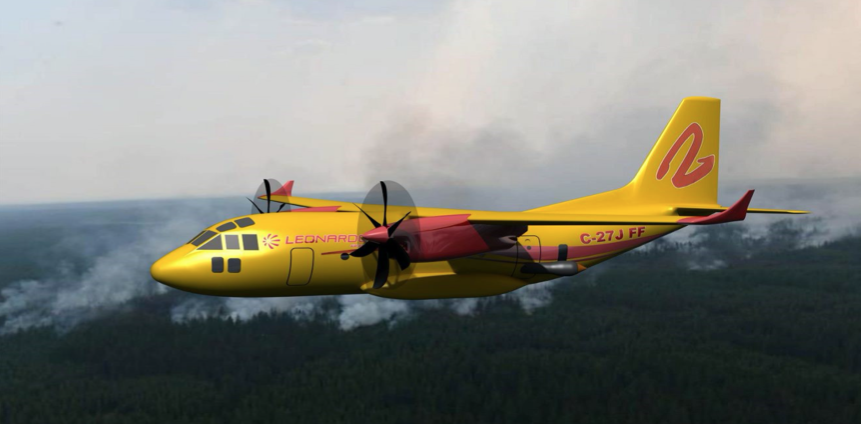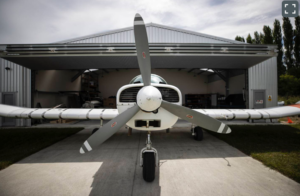
Leonardo Unveils New Firefighting Configuration For The C-27J Next Generation
BY: STEFANO D’URSO
Leonardo has released a new MAFFS driven firefighting configuration that will further expand the capabilities of the C-27J Spartan Next Generation cargo aircraft. The company was already working for some years on this project, studying the various options, but the choice in the end went to the second generation, roll-on/roll-off Modular Airborne Fire Fighting System (MAFFS II).

The C-27J NG will now be able to follow the footsteps of its predecessor, the G-222 (also known as C-27A), which was adapted to the firefighting role by equipping it with a system inspired by the early versions of the MAFFS, called Sistema Aeronautico Antincendio (Aeronautic Firefighting System). Four aircraft were built in this configuration for the Italian Air Force.
In the last few years, we saw an increase in the number of fires around the world, whose growing complexities are forcing the individual countries to deal with the challenge in an integrated manner, increasing the firefighting capabilities while taking the specific needs of each country into account. Those fires often spread on large areas and last many days, requesting a lot of resources to deal with them effectively. One of those resources, which is being increasingly employed in those situations, is the aerial firefighting aircraft.
As highlighted by Leonardo, an effective firefighting system has to meet a number of requirements: reach remote inland areas that are cut off from the sea or other water basins; optimise emergency response times; reduce environmental impact; employ multi-mission solutions that can cut aircraft operating costs, while ensuring their continuous use, even in the winter months; ensure the availability of a vast number of common platforms with elevated operational flexibility that can deal with a variety of different missions, and the “aircraft system” must have a high degree of interoperability with the assets on the ground.
Aircraft, which are at the heart of this integrated firefighting system, are the most powerful tool available to assist ground personnel fighting the flames. The C-27J’s Fire Fighter configuration proposed by Leonardo, considered the state-of-the-art in airborne firefighting capabilities, is a flexible solution, ideal for enhancing the capabilities of the C-27J Next Generation multi-mission aircraft and has significantly lower purchasing and operating costs than a dedicated firefighting platform, since it can be used for a multitude of missions instead of just a specialized role.

In around 90 minutes, the C-27J can be transformed from a tactical transport aircraft to an aerial firefighter, thanks to the palletised Modular Airborne Fire Fighting System II (MAFFS II), developed by United Aeronautical Corporation, a world leader in advanced aerial application systems. The MAFFS was first developed in the 1970’s to equip U.S. Air Force’s C-130s so they could help civilian agencies to fight fires, should they need additional assets. A newer variant, the MAFFS II, became operational in the 2000s.
The system consists in the installation in the C-27’s cargo bay of a removable tank with a capacity of over 8,000 litres of water or 7,600 litres of fire-retardant liquid. A complete set of tools that includes a pressurised tank, an outlet nozzle, a pressurised door, and a ground support system. The MAFFS II discharges the water or the retardant through a special plug in the paratroop drop door on the side of the aircraft, rather than requiring the cargo ramp door to be opened like on the original MAFFS.
According to Leonardo, the C-27’s Firefighting configuration is not intended to completely replace amphibious firefighting aircraft like the Canadair CL-415. Instead, it is designed so both types of aircraft can be used in a complementary way to optimize firefighting effectiveness even in complex environmental or morphological conditions, such as high distance of the basins, adverse weather conditions (high waves, bad weather), or to support operations at low visibility and night.
The C-27J-based firefighting solution is just the latest of the rapidly reconfigurable roles to which the aircraft has been adapted since its entry into service. This multi-functionality proved extremely useful for a variety of civil protection operations, other than the aircraft’s traditional military roles. A multitude of kits and easy-to-install, transportable roll-on/roll-off mission systems allow the C-27J to be rapidly transformed into the required configuration for the mission at hand.
As a tactical airlifter, the aircraft’s versatility also extends to airlifting cargo and troops; airdropping parachutists and supplies; medical battlefield evacuation; VIP transportation; natural disaster response and humanitarian assistance and support. In fact, during the crucial stages of the Covid-19 pandemic, the aircraft was primarily used for transporting medical supplies and equipment, ferrying medical personnel and coronavirus patients, and, in some cases, for complex transport operations that required the use of bio-containment kits.
SOURCE: https://theaviationist.com/2022/05/20/c-27j-firefighting-configuration/


